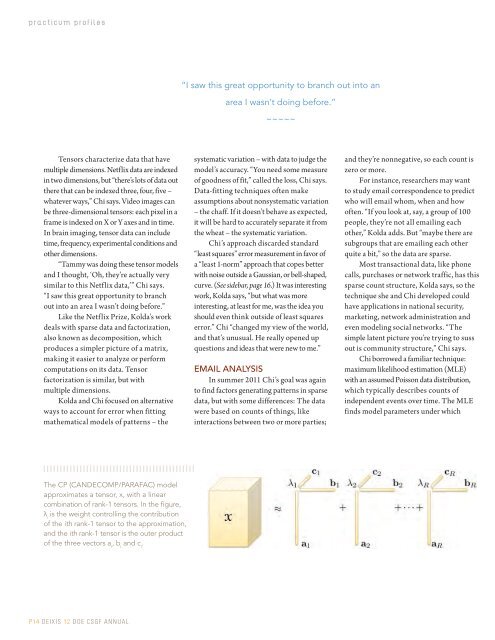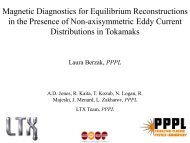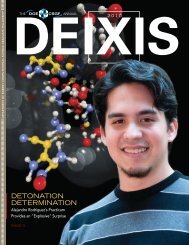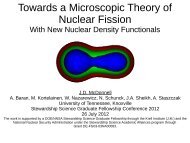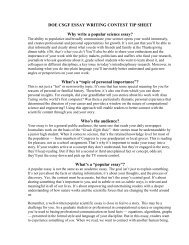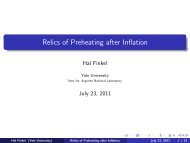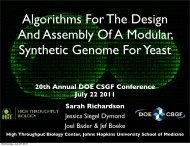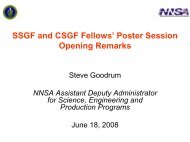2012 - Krell Institute
2012 - Krell Institute
2012 - Krell Institute
You also want an ePaper? Increase the reach of your titles
YUMPU automatically turns print PDFs into web optimized ePapers that Google loves.
practicum profiles<br />
“I saw this great opportunity to branch out into an<br />
area I wasn’t doing before.”<br />
~~~~~<br />
Tensors characterize data that have<br />
multiple dimensions. Netflix data are indexed<br />
in two dimensions, but “there’s lots of data out<br />
there that can be indexed three, four, five –<br />
whatever ways,” Chi says. Video images can<br />
be three-dimensional tensors: each pixel in a<br />
frame is indexed on X or Y axes and in time.<br />
In brain imaging, tensor data can include<br />
time, frequency, experimental conditions and<br />
other dimensions.<br />
“Tammy was doing these tensor models<br />
and I thought, ‘Oh, they’re actually very<br />
similar to this Netflix data,’” Chi says.<br />
“I saw this great opportunity to branch<br />
out into an area I wasn’t doing before.”<br />
Like the Netflix Prize, Kolda’s work<br />
deals with sparse data and factorization,<br />
also known as decomposition, which<br />
produces a simpler picture of a matrix,<br />
making it easier to analyze or perform<br />
computations on its data. Tensor<br />
factorization is similar, but with<br />
multiple dimensions.<br />
Kolda and Chi focused on alternative<br />
ways to account for error when fitting<br />
mathematical models of patterns – the<br />
systematic variation – with data to judge the<br />
model’s accuracy. “You need some measure<br />
of goodness of fit,” called the loss, Chi says.<br />
Data-fitting techniques often make<br />
assumptions about nonsystematic variation<br />
– the chaff. If it doesn’t behave as expected,<br />
it will be hard to accurately separate it from<br />
the wheat – the systematic variation.<br />
Chi’s approach discarded standard<br />
“least squares” error measurement in favor of<br />
a “least 1-norm” approach that copes better<br />
with noise outside a Gaussian, or bell-shaped,<br />
curve. (See sidebar, page 16.) It was interesting<br />
work, Kolda says, “but what was more<br />
interesting, at least for me, was the idea you<br />
should even think outside of least squares<br />
error.” Chi “changed my view of the world,<br />
and that’s unusual. He really opened up<br />
questions and ideas that were new to me.”<br />
EMAIL ANALYSIS<br />
In summer 2011 Chi’s goal was again<br />
to find factors generating patterns in sparse<br />
data, but with some differences: The data<br />
were based on counts of things, like<br />
interactions between two or more parties;<br />
and they’re nonnegative, so each count is<br />
zero or more.<br />
For instance, researchers may want<br />
to study email correspondence to predict<br />
who will email whom, when and how<br />
often. “If you look at, say, a group of 100<br />
people, they’re not all emailing each<br />
other,” Kolda adds. But “maybe there are<br />
subgroups that are emailing each other<br />
quite a bit,” so the data are sparse.<br />
Most transactional data, like phone<br />
calls, purchases or network traffic, has this<br />
sparse count structure, Kolda says, so the<br />
technique she and Chi developed could<br />
have applications in national security,<br />
marketing, network administration and<br />
even modeling social networks. “The<br />
simple latent picture you’re trying to suss<br />
out is community structure,” Chi says.<br />
Chi borrowed a familiar technique:<br />
maximum likelihood estimation (MLE)<br />
with an assumed Poisson data distribution,<br />
which typically describes counts of<br />
independent events over time. The MLE<br />
finds model parameters under which<br />
The CP (CANDECOMP/PARAFAC) model<br />
approximates a tensor, x, with a linear<br />
combination of rank-1 tensors. In the figure,<br />
is the weight controlling the contribution<br />
i<br />
of the ith rank-1 tensor to the approximation,<br />
and the ith rank-1 tensor is the outer product<br />
of the three vectors a i<br />
, b i<br />
and c i<br />
.<br />
P14 DEIXIS 12 DOE CSGF ANNUAL


